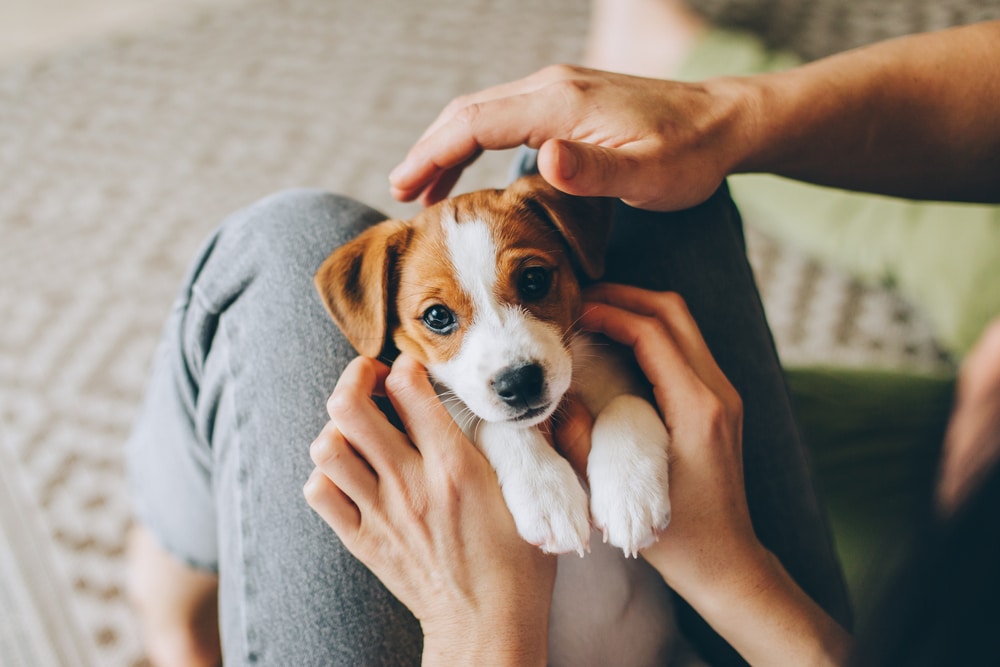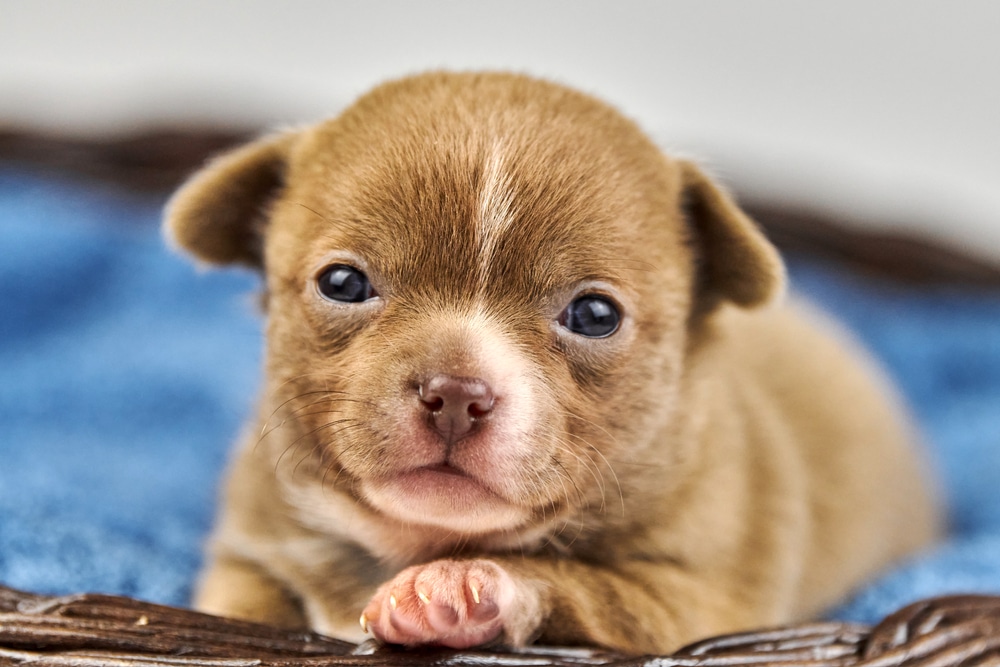Puppies, in contrast to human infants, are born with their eyes shut. At birth, puppies are effectively deaf and blind and can only slowly crawl around. They’re also entirely dependent on their mother for weeks after birth and navigate the world only through smell. So when can a puppy finally open its eyes?
Puppies generally open their eyes 10-14 days post-birth. However, some breeds of puppy may take up to 21 days. If your puppy has yet to open its eyes after 2 weeks, visit a vet to ensure there are no medical complications at play or that the pup isn’t blind. It takes 8 weeks on average for full eye and vision development in young dogs.
Table of Contents
- Why Are Pups Born With Closed Eyes?
- When Do Puppies Open Their Eyes?
- Eye-Opening Process in Puppies
- Vision Development Process in Puppies
- What Can Neonate Puppies See After Two Weeks?
- What To Do If Your Pup’s Eyes Are Still Closed?
- Watch Out for Eye infection In Pups
- Tips To Look After Your Pup’s Eyes
- In Conclusion: When Can A Puppy Open Its Eyes
Why Are Pups Born With Closed Eyes?
In puppies, eyes are not fully developed at the time of birth. The eyelids protect the developing eye and keep it clean and moist. The clear portion of the eye, called the cornea, is not fully developed either, so it needs to be protected too.
The eyelids also help keep light out so the pup can sleep and rest. Pups need a lot of sleep since they’re growing and developing quickly. Too much light exposure at this stage can actually damage their eyes.
When Do Puppies Open Their Eyes?

Puppies start to open their eyes 10 to 14 days after birth. The eyelids stay closed for those first couple of weeks for a very good reason—the nerves in a newborn puppy’s eyes are still underdeveloped and are very sensitive. Some puppies will open both eyes at the same time, while others will open one eye first before the other.
Eye-Opening Process in Puppies
When puppies are born, their eyelids are sealed shut. The lids remain closed until the puppy reaches 10-14 days old, at which point they begin to open, revealing the immature eyeball.
The 14-day-old eyeball is bluish to gray in color due to the lack of pigmentation in the iris (the colored portion of the eye). Additionally, the cornea (the clear outer layer of the eye) may appear hazy or opaque.
Vision Development Process in Puppies
Over the first few weeks of life, their vision steadily improves. Here are the stages of puppy vision development.
First 2 Weeks – Nerve Development Occurs
During the first two weeks of life, the puppies’ nervous system is developing. This is when they are learning to respond to stimuli and beginning to develop their senses. The puppies are especially sensitive to noise during this time and can startle easily.
It is important to be gentle and avoid loud noises around them. They are also sensitive to movement, so it is best not to jostle them around too much. The puppies are starting to learn how to interact with their surroundings, and it is important to provide them with a calm and safe environment during this critical time.
2–6 Weeks – Vision Begins To Develop
The first thing puppies have to do during the vision development process is adjust to the new light. This can be a bit difficult since their eyes are still adjusting to being open.
At the same time, puppies are also trying to figure out how to focus on things. It takes a little bit of time for them to get used to both the light and being able to see clearly.
Once the puppies have adjusted to the light and can focus on things, they will start to explore their surroundings. This is a very important part of their development, as they are learning about their new home and what is around them.
6–8 Weeks – Vision Becomes Sharp & Clearer
By six to eight weeks old, puppies begin to see more clearly. This is when they start to develop their adult eye color and can better distinguish between shapes and colors.
Their peripheral vision also improves, so they can better see what’s happening around them. They can see fully at around eight weeks old.
8 Weeks or Above – Fully Matured Vision Of Puppies
By eight weeks of age, puppies’ eyes will have reached full development, and they should be able to see clearly. The iris will have taken on its adult coloration, and the cornea will be clear and transparent.
However, some breeds of dogs may take longer to develop fully pigmented irises and completely clear corneas.
What Can Neonate Puppies See After Two Weeks?
See the list below for what neonate puppies can see after two weeks:
- Neonate puppies are only able to see shapes and movement after two weeks.
- They can also see colors, but they may still not be able to differentiate between all of them.
- Their vision is limited; they can only see up to about two feet away.
What To Do If Your Pup’s Eyes Are Still Closed?
The time it takes for puppies to open their eyes can differ from puppy to puppy, but here are some things you can do if you’re concerned:
- If more than two weeks have passed since your puppy was born and their eyes are still closed, take them to the vet. Your doctor may clean your puppy’s eyes and try opening them by hand. If an infection is present, antibiotics might be recommended for follow-up care.
- If you are unable to bring your puppy to the vet right away, try massaging their eyelids gently with a cotton ball that has been dampened in warm water. Never attempt to force them open by any means.
- If you notice your puppy’s eyes are swollen or there is pus coming from them, you will need to take them to the vet as soon as possible. This could be a sign of an infection, which will require antibiotics for treatment.
Watch Out for Eye infection In Pups
Puppies are especially susceptible to eye infections since their immune systems are not yet fully developed. Bacteria and viruses can easily enter the puppy’s body through their eyes, which can lead to serious infections. The most frequent issues are the following, starting with entropion.
1. Entropion
Entropion is a condition where the puppy’s eyelid rolls in, causing the lashes to rub against the cornea. This is a hereditary eye problem that often affects both the bottom and top eyelids.
The signs of entropion are easy to spot and include squinting, holding the eye shut, and excessive tearing. If your dog displays any of these symptoms, take them to the vet immediately, as surgery is the only cure. Many dogs cannot have surgery until they are at least six to twelve months old.
2. Dry Eye
This disease occurs when there is inadequate production of tears. Tears are important because they help lubricate the eye and carry away foreign material. Without enough tears, a puppy may experience excessive blinking, pawing at the eye, and discharge.
If left untreated, dry eye disease can cause permanent damage to the cornea. Treatment options are available that can help relieve the symptoms and slow the progression of the disease.
3. Corneal Injuries
Corneal injuries are one of the most common eye problems for puppies. The cornea is the clear outer layer of the eye. Foreign objects, such as sticks or dirt, can easily injure it.
Signs your puppy has a corneal injury include squinting, pawing at the eye, redness, and discharge. If you notice any of these symptoms, take your puppy to the vet right away so the vet can treat them.
Your pup will feel a lot of discomfort if its cornea is injured. It may paw at its eye and try to rub it. The cornea can also become cloudy or opaque, making vision difficult. If the injury is severe enough, it could even lead to blindness.
Treatment for a corneal injury will vary depending on the severity of the injury. For minor injuries, your vet may prescribe antibiotics and anti-inflammatory medication. More severe injuries may require surgery to repair the damage.
Tips To Look After Your Pup’s Eyes
Your pup’s eyes are one of the most important features on their face, so it’s important to take care of them! Here are a few tips to help you keep your pup’s peepers healthy and happy.
1. Keep Their Eyes Clean
You should wipe your pup’s eyes with a damp cloth every day to remove any dirt, debris, or discharge. If you notice your pup’s eyes are red or irritated, you can use a dog-safe eye wash to clean them.
2. Watch For Signs Of Eye Problems
If you notice your pup is squinting, rubbing its eyes, or has red or swollen eyes, it may be experiencing an eye problem. If you notice any of these signs, take them to the vet so the vet can treat them.
3. Regular Checkups
Make sure to take your pup for regular checkups with the vet, especially if they are prone to eye problems. The vet will be able to detect any issues early on and treat them accordingly.
4. Trimming Their Nails
Make sure to keep your pup’s nails trimmed, so they don’t scratch their eyes. You can cut their nails yourself or take them to a groomer to have them done.
In Conclusion: When Can A Puppy Open Its Eyes
A puppy’s eyes usually open between 10-14 days after birth. During this time, the pup’s vision is not very good, and they are not able to see clearly. As the weeks go on, their vision will improve.
By the time they are eight weeks old, their vision should be similar to adult dogs. Consult your veterinarian if you think your puppy’s vision is not developing properly.
Have you ever experienced something similar with your puppies? Share your stories with us in the comments below!
